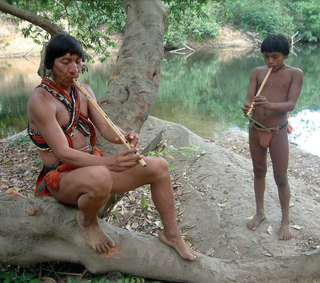Related Research Articles
A lateral is a consonant in which the airstream proceeds along one or both of the sides of the tongue, but it is blocked by the tongue from going through the middle of the mouth. An example of a lateral consonant is the English L, as in Larry. Lateral consonants contrast with central consonants, in which the airstream flows through the center of the mouth.

The Yaruro people are a Circum-Caribbean indigenous people, native to the ecoregion of Llanos in Venezuela, located west of the Orinoco River. The Pumé people are divided into two subgroups: The River Pumé, living along major river drainages of the Orinoco River, and the more nomadic Savanna Pumé that reside on the Llanos.

Yanam, or Ninam, is a Yanomaman language spoken in Roraima, Brazil and southern Venezuela near the Mucajai, upper Uraricaá, and Paragua rivers.

Arawakan, also known as Maipurean, is a language family that developed among ancient indigenous peoples in South America. Branches migrated to Central America and the Greater Antilles in the Caribbean and the Atlantic, including what is now the Bahamas. Almost all present-day South American countries are known to have been home to speakers of Arawakan languages, the exceptions being Ecuador, Uruguay, and Chile. Maipurean may be related to other language families in a hypothetical Macro-Arawakan stock.

Arutani–Sape, also known as Awake–Kaliana or Kalianan, is a proposed language family that includes two of the most poorly documented languages in South America, both of which are now extinct. They are at best only distantly related. Kaufman (1990) found a connection convincing, but Migliazza & Campbell (1988) maintained that there is no evidence for linking them. The two languages are,
Latin American literature consists of the oral and written literature of Latin America in several languages, particularly in Spanish, Portuguese, and the indigenous languages of the Americas. It rose to particular prominence globally during the second half of the 20th century, largely due to the international success of the style known as magical realism. As such, the region's literature is often associated solely with this style, with the 20th century literary movement known as Latin American Boom, and with its most famous exponent, Gabriel García Márquez. Latin American literature has a rich and complex tradition of literary production that dates back many centuries.
The Piaroa–Saliban, also known as Saliban, are a small proposed language family of the middle Orinoco Basin, which forms an independent island within an area of Venezuela and Colombia dominated by peoples of Carib and Arawakan affiliation.
Estévez, or Estevez in English, is a Galician (Spanish) family name. It is a patronymic, meaning son of Stephen, in Galician Estevo. In Portuguese the equivalent is Esteves, the Italian equivalent is Di Stefano and Stefani and the Spanish equivalent is Estébanez, from the Spanish name Esteban.
Arutani is a nearly extinct language spoken in Roraima, Brazil and in the Karum River area of Bolivar State, Venezuela. There are only around 6 speakers left.
Sapé a.k.a. Kaliana is an extinct language recently spoken along the Paragua River and Karuna River. There were only about a few dozen speakers in the mid-1900s, and by the 2000s, only a few elderly speakers were found. Sapé may be a language isolate.
Guahibo, the native language of the Guahibo people, is a Guahiban language that is spoken by about 23,006 people in Colombia and additional 8,428 in Venezuela. There is a 40% rate of monolingualism, and a 45% literacy rate.
The languages of Venezuela refers to the official languages and various dialects spoken in established communities within the country. In Venezuela, Castillan is the official language and is the mother tongue of the majority of Venezuelans. Although there is an established official language, there are countless languages of indigenous villages spoken throughout Venezuela, and various regions also have languages of their own.
The Hodï language, also known as Yuwana (Yoana), Waruwaru, or Chikano (Chicano), is a small unclassified language spoken by the Hodï people of Venezuela. Very little is known of it; its several hundred speakers are monolingual hunter-gatherers. The people call themselves Jojodö or Wįlǫ̈, and their language Jojodö tjįwęnę.
Piaroa is an indigenous language of Colombia and Venezuela, native to the Huottüja people. Loukotka (1968) reports that it is spoken along the Sipapo River, Orinoco River, and Ventuari River.
The South American Board of New Football Federations, also known by its acronym COSANFF is the administrative and controlling body for non-FIFA football federations in South America. It was also initially affiliated with the now defunct N.F.-Board.
Abane (Avane), one of several languages called Baniwa, also known as Baniva Yavitero, was an Arawakan language of Venezuela. It is believed to have become extinct by the late 20th century, and is only attested in a short word-list from the late 18th century.

Fèlix Cardona i Puig was a Spanish explorer of the Venezuelan Guyana.

The Hodï or Jotï are a small group of indigenous people who live in the Amazon rainforest in Venezuela. The last census held in Venezuela, in 2011, registered 982 individuals identifying as Hodï; a 2016 estimate accounted a population of around 1200. They speak the Hodï language and are closely related to the Piaroa people, although linguistic connections between the two people groups have not reached consensus among scholars. They are also known by a number of exonyms as the Hoti, Chicano, Shikana, Yuana, Waruwarú, or Rua.